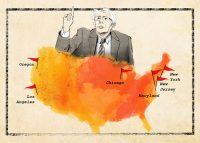As she tried to hold onto her seat representing one of Illinois’ most progressive districts on Chicago’s northwest side, Sen. Natalie Toro vowed to fight to lift the state’s ban on rent control.
It wasn’t enough.
She lost her Democratic primary to Graciela Guzmán, who also supports removing the ban but whose progressive bonafides were boosted by an endorsement from U.S. Sen. Bernie Sanders.
Just before the March primary, Toro introduced her bill, but as with previous attempts at legalizing local rent control, the bill failed to move forward.
Toro’s bill wasn’t seen as a threat by real estate lobbyists, they said, and she didn’t put up much of a fight. She introduced an older version of legislation crafted by Chicago’s Lift the Ban Coalition – which is pushing for a new bill in the House – suggesting a lack of coordination with the group. Toro’s bill died after she didn’t call it in time to meet a legislative deadline.
“I don’t know to what degree (Toro) believes in the issue, but I think she introduced the bill because she believed the politics were good,” said state Rep. Will Guzzardi, who has introduced a series of bills to lift the ban since 2017. “And that just goes to show you how far this issue has come.”
Indeed, Chicago voters in particular seem keen to lift the ban, and the blue state’s Democratic governor has voiced his support, as well. Building support in Chicago is one thing, but the Lift the Ban Coalition said they will need to continue mobilizing renters in other parts of the state to really put pressure on legislators.
Illinois is not the only rent control battleground state, but most attempts to allow towns and cities to moderate rents have failed thus far.
California voters are gearing up to vote in November on whether to allow cities and towns to impose rent control on newer apartments, as well as condos and townhouses. Last year an effort in Colorado gained momentum before ultimately stalling.
New York state underscored its commitment to rent regulation measures in a 2019 law, and cities north of New York City — where rent stabilization is firmly in place — have been saying yes to local measures at a steady click.
Rent control fights have been playing out across the country for decades, pitting organizers and politicians who say control is needed to address displacement and rising rents against landlords and developers who warn that it’ll hamper new construction, prevent landlords from making repairs and render housing less affordable for those in unregulated apartments.
Legislative “whack-a-mole”
Illinois is one of dozens of states where legislators passed preemptive rent control bans between the 1970s and 1990s.
Like other state prohibitions, the one in Illinois used language from a model policy called the “Rent Control Preemption Act” crafted by the conservative lobbying group American Legislative Exchange Council.
For decades since, Illinois Realtors association — whose lobbyists were key in getting the ban passed back in the ‘90s — has played “whack-a-mole,” CEO Jeff Baker said, working to quash any legislation that looks like rent control.
“There’s typically at least one bill every year that tries to address rent control; whether or not it’s aggressively pursued is a different question,” he said.
Each session, the association works with other industry groups, such as the Neighborhood Building Owners Alliance and the Chicagoland Apartment Association to monitor proposals. If one gains momentum, the groups mobilize, reaching out to legislators and voters with messaging about the potential harms of rent control, said Mike Hagenson, chair of NBOA’s advocacy and policy committee.
Illinois Realtors has proven its ability to crush legislation. Most recently, it spent over $1 million on mailers, streaming advertisements and get-out-the-vote efforts to oppose Mayor Brandon Johnson’s proposal to increase Chicago’s real estate transfer tax to fund homelessness services, which failed at the ballot box in March.
The association similarly rallied members to call and email state Rep. Guzzardi, along with their own representatives in 2017 when he introduced the first in a series of bills to lift the state’s rent control ban, Guzzardi said.
His bills had the most momentum of any recent efforts to lift the statewide ban, but none made it to a full vote. That was due to the combined lobbying power of real estate and trade labor unions and the fact that progressives were focused on passing a clean energy bill at the time, said a Chicago Democratic strategist who spoke with The Real Deal under the condition of anonymity due to ongoing work with the Illinois General Assembly.
Illinois’ top trade labor political action committees shell out large sums of money to Senate and House leadership to push their agenda and rent control isn’t part of that agenda, the strategist said.
The Chicagoland Operators Joint Labor-Management PAC, for example, has donated a total of $5.5 million to Senate President Don Harmon as of Feb. 23. Carpentry Advancement Political Action has donated $1 million to Harmon and at least $1.2 million to Illinois House Speaker Emanuel Chris Welch.
Their power may have had a hand in the lifelessness of Toro’s bill.
In the late summer and fall of 2023, Toro received over $73,000 in donations from the two committees – among Illinois’ highest-spending trade labor groups – which have helped put an end to past measures to lift the rent control ban, according to the strategist.
When asked about this, a campaign spokesperson declined to comment on Toro’s behalf.
To lift the ban
The Lift the Ban Coalition was formed in 2017 to push for rent control in Illinois. Tenants joined with 37 community organizations, unions and political groups across Illinois. It was the same year that Guzzardi began introducing bills.
Early on, data suggested their cause resonated with Chicago voters.
When Lift the Ban organizers pushed for non-binding ballot questions in two 2018 elections asking voters in a total of 12 wards if they wanted to lift the statewide rent control ban, they found the average rate of support was 74 percent.
The support isn’t a mystery. Housing prices in Chicago are already unaffordable for many; residents making minimum wage would have to work 71 hours a week to afford a modest one-bedroom apartment at the going market rate, according to the National Low Income Housing Coalition.
This has contributed to high levels of displacement in the city as well as suburban and rural areas throughout Illinois.
Chicago’s Black population in particular has been declining since 1980, when it peaked at 1.19 million residents. By 2017, it had dropped by a third, according to the University of Illinois Chicago’s Great Cities Institute. The quickest decline spanned from 2000 to 2010 when over 181,000 Black residents were displaced, many of them from South Side communities hit hard by the 2008 foreclosure crisis.
Across the nation, a record 22.4 million renters were cost-burdened – defined as paying more than 30 percent of income on housing – in 2022, according to a recent study from the Joint Center for Housing Studies at Harvard University.
Rent control became a hot issue in the 2018 gubernatorial election. Illinois Governor J.B. Pritzker, heir of the Hyatt hotel chain, went on record supporting lifting the ban.
The coalition gained the support of two of the city’s most powerful progressive unions: the Chicago Teachers Union in 2019 and SEIU Health Care Illinois/Indiana.
That has given the movement more clout, said the Democratic strategist, but the teachers union and Mayor Johnson have yet to take up rent control as a political priority. Many still see Chicago as an affordable place to live relative to other major urban areas like New York or Los Angeles, the strategist added.
In 2021, with the housing crisis deepened by the pandemic and a statewide moratorium on evictions in place, Guzzardi tried to lift the ban again. This time, his bill cleared the Housing Committee, which he then chaired, but it later stalled out in the Rules Committee.
The coalition’s latest legislative proposal is HB 4104, which was introduced by state Rep. Hoan Huynh in the House last year and gained six new sponsors this year for a total of 14, including Guzzardi. The bill calls for a binding statewide referendum to let voters decide if the ban should be lifted.
As Toro chose to introduce an older proposal for her bill this year, no matching bill was brought forward in the Senate – a necessary step as any bill must pass through both houses to become law. HB 4104 stalled out in the Rules Committee but is set to be reintroduced in the coming session, according to coalition member Diego Morales.
Morales attributed the previous lack of political will to city and state politicians striking up controversial alliances with the real estate industry. A fresh cast of elected officials could spark momentum as 16 incumbent Chicago aldermen – more than 30 percent of the City Council – didn’t run in the 2023 local municipal election.
“It’s a new day,” Morales said.
A picture of rent control in Chicago
Delmarie Cobb is a long-time Chicago resident, former journalist and current political consultant. She is also the landlord of an owner-occupied six-flat at 35th and South King Drive, in a historic Black neighborhood on Chicago’s South Side.
Typically a very progressive Chicago voter, Cobb said the issue of rent control feels complicated for her as a small-time landlord who would struggle to fund large repairs if she encountered unexpected costs and was unable to raise rents, she said.
Opponents of rent control, including many economists, often cite three main arguments – one of which is that the restriction of rental rates may prevent or dissuade landlords from making necessary or beneficial repairs to buildings, said David Schleicher, a Yale Law School property and urban law professor.
Larger landlords who oppose rent control likely have more of a financial safety net than Cobb, particularly if they do not reside in the properties they rent, but she said owners like her often feel similarly to tenants: They don’t have enough rights in protecting themselves from financial precarity or legal disputes.
Those in favor of rent control say that Cobb and landlords like her would be protected. The Lift the Ban Coalition released an outline of how to approach rent control should the state ban fall. They imagine an exemption for owner-occupied buildings of six units or fewer and annual limits on rent increases purposefully set higher than the average increase in rent, Morales said.
“What we’re trying to stave off are those very predatory instances, of which there are many, when a buyer comes in, kicks everybody out and jacks up the rents a much more astronomical amount – 50 percent, 100 percent, 200 percent,” he said.
Another well-known problem with rent control is that the price limits don’t always end up helping people who are most in need of affordable housing. People who might be financially able to live in market rate housing still seek out or remain in rent-controlled units, Schleicher said, or they might stick around even if financial circumstances improve or family size changes.
“It’s not a policy designed to help the poor,” he explained. “It’s a policy designed to limit rents, which may help the poor, but it’s not a targeted welfare-like policy that aims at people with income problems. It’s aimed at stabilizing neighborhoods.”
But the concerns top of mind for Illinois real estate lobbyists and Drew Breneman, founder of Chicago-based investment firm Breneman Capital, are how rent control could hamper new construction, diminish supply and increase the cost of market-rate housing.
The majority of U.S. economists share this concern. But there are some cracks in the consensus as more studies of rent regulation publish results showing that real-life outcomes don’t necessarily follow predictions of the simple supply-and-demand model.
Studies of rent control in New Jersey conducted in 2007 and 2015, for example, found that government oversight of rents didn’t reduce the supply of rental housing. There were similar findings in San Francisco and Massachusetts, according to an article by J.W. Mason, a professor of economics at John Jay College of the City University of New York.
Postcard from California
In California, policymakers have paired rental regulation with pro-development policies, and the state’s shifting politics around rent control offer an imperfect preview of what could play out in Illinois in coming years.
California has more than a dozen rent-controlled cities and a statewide rent control measure enacted in 2020 that restricts annual rent increases to no more than 5 percent plus the local inflation rate.
At the same time, California has a statewide ban on municipalities enacting rent control, but only for properties built after 1995, or on condos, townhouses or free-standing homes. Landlords also have the right to raise rent on any unit to market rate once a tenant moves out.
The largest rent-controlled city is Los Angeles, which passed its first policy in the 1940s when the city couldn’t build quickly enough to affordably accommodate a large population surge toward the end of the Great Depression.
By the ’90s, developers had become increasingly concerned that rental regulations in L.A. and elsewhere could end up preventing new construction, said Sean Burton, CEO of Los Angeles-based development firm Cityview. This led to the 1995 law prohibiting cities from controlling rent in new construction.
On the other hand, the 2020 statewide rent control policy doesn’t prevent new development even as it checks rising rents and protects tenants against wrongful eviction. And more supply keeps pricing down, he said.
“You have to build more housing. It’s really no more complicated than that,” Burton said. “We have a lack of new supply that’s staggering.”
Breneman, the Chicago investor, agreed, saying his city’s higher vacancy rate has kept rents down relative to other big cities. Chicago’s rental vacancy rate among more affordable properties fell below 5 percent in the first quarter of 2024, but remains higher than that of Los Angeles (3.3 percent) and New York City (1.4 percent), according to Yahoo! Finance and CoStar.
A measure on the November ballot in California would repeal the 1995 ban, known as the Costa-Hawkins Rental Housing Act. This is the third such attempt, with all three funded by the same L.A.-based nonprofit executive, AIDS Healthcare Foundation president Michael Weinstein, according to Politico.
California State Sen. Toni Atkins and Appropriations Chair Buffy Wicks in the California House have both come out against the referendum, breaking from the official stance of the state Democratic Party. The United Brotherhood of Carpenters and Norcal Carpenters Union, two of California’s largest construction unions, also oppose the initiative.
Many politicians have soured on Weinstein’s measure. Some believe one of its provisions could be used by local Republicans in wealthy coastal cities – like L.A. suburb Huntington Beach – who want to pass overly restrictive rent control on purpose to block new development, Politico reported. His campaign has refuted the proposal would have such an effect if passed.
While Weinstein’s referendum still has the support of liberal housing organizers in California who want to see the ban lifted, some top state Democrats and pro-development or “YIMBY” advocates have joined real estate industry players like Burton in opposing the measure.
Matthew Lewis of California YIMBY maintained that the measure, known as the “Justice for Renters Act,” would allow localities to circumvent pro-housing development laws.
The California Apartment Association, a landlord trade group, has spent millions to put forward a different ballot measure with the explicit aim to “stop the Weinstein scam.” The measure would forbid Weinstein from using funding from his nonprofit foundation on the referendum, effectively cutting off his ability to finance the campaign as he has in the past.
YIMBY advocates share some end goals with pro-rent control groups – lower rent rates, more sustainable housing, more empowered tenants – but fundamentally disagree on how to get there, Lewis said.
Rather than rent control, Lewis sided with real estate and trade groups in pushing for pro-development policies and changes to zoning laws to allow construction of more affordable housing and mixed-use properties.
Illinois rent control organizers are open to these policies but want rent regulations to be part of a broader “suite of tools” available to local leaders who are trying to “stop the bleeding” of the housing crisis in Chicago and other areas of the state, Morales of the Lift the Ban Coalition said.
And with or without the perfect champion in Springfield, they’ll keep pushing for a statewide referendum on lifting the ban, Morales said.
“We can’t wait for the right political leadership, we have to organize,” he said. “That is how we have gotten this far. It has to be the voice of the people who are affected by this issue. That should make it a priority for anybody, regardless of who’s in leadership.”
Editor’s note: This story has been updated to correct Weinstein’s place of residency and to add that the California Democratic Party has endorsed his measure.
Read more



